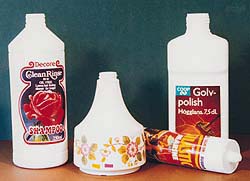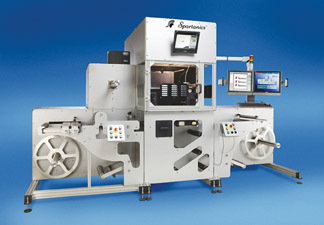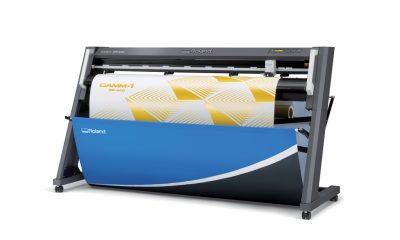Graphics Printing
Published
12 years agoon

Have you ever bought a new computer and then a month later you see a better model with more features for two-thirds of the price you originally paid? We all have! The same situation can arise when evaluating color-management aids or tools. The way to avoid falling into this pitfall is to find the right solution for the specific job. Ensure that the hardware or software you intend to get will help you to meet the set goal.
Have you ever bought a new computer and then a month later you see a better model with more features for two-thirds of the price you originally paid? We all have! The same situation can arise when evaluating color-management aids or tools. The way to avoid falling into this pitfall is to find the right solution for the specific job. Ensure that the hardware or software you intend to get will help you to meet the set goal.
The purpose of this article is to give insight into the many options available for color-management tools. This is a big topic; therefore, it would be impossible to mention every tool, piece of hardware or software. Most color-management aids and tools cross over between digital and separation workflows.
A color-management aid or tool is normally classified as a software package or an instrument. If it is software-based, an instrument to capture color data is required. You have to get the color data into the software to complete the evaluation. Many instruments have the ability to report color data back to the user, eliminating the need for computer software. However, if capturing data for future reference is the goal, software-based color-management tools would be recommended.
Before you invest in a color-management aid, first, clearly define what you’re trying to achieve. Ask, why do I need a color-management aid? What am I trying to accomplish? Good examples of color management goals requiring an aid or tool are:
Develop a control point in production to gauge print consistency and repeatability.
Compare the printed color to an industry specification.
Evaluate print-color consistency from printer to printer.
Gauge print consistency from the color-approved press sheet through the end of the production run.
Create media configurations for new materials in digital printing.
Develop press curves to achieve gray balance control.
In each of the color-management goals listed, it’s nearly impossible to complete any of the goals without some form of tool or aid. Imagine working as a plumber and the only tool you had was a pair of needle-nose pliers when the job called for a pipe wrench. The same mindset can be used when it comes to color-management aids and tools. Pick the right tool for the job. It is amazing to see how many printers are using needle-nose pliers when the job calls for something else entirely.
Color-data capture
Spectrophotometers measure the intensity of wavelengths in a spectrum of light and then compare that measurement with the intensity of light from a standard source. When using a spectrophotometer, color data can be reported back in several formats, but typically L*a*b* color space is used.
One of the most common spectrophotometers in the field would be is the i1 Pro by X-Rite (Figure 1). X-Rite recently introduced the new i1 Pro 2. Like the i1 Pro, the i1 Pro 2 is a hand-held device, which relies on computer software to capture the color data. X-Rite also has an i1iSis spectrophotometer, which captures color data one page at a time. The i1iSis is normally faster than a hand-held portable device, capturing the color data of 1500 patches in less than eight minutes, but limited to a paper thickness of 0.08-0.45 mm. So, if you have a material thicker than 0.45 mm, make certain to get a portable hand-held spectrophotometer.
Barbieri has introduced a hand-held spectrophotometer called the SpectroPad (Figure 2). This device is portable and includes a touchscreen. The SpectroPad does not require a connection to a computer to capture print data. The device can connect to a computer via Wi-Fi. The SpectroPad has a 6 mm aperture, which makes reading in low-resolution print data much easier. Because this device rides on top of the material, there are no limitations to material thickness.
When it comes to controlling color in press, the densitometer has been the device of choice for many years. A good densitometer is really still a must-have item for press control. Densitometers have matured to include the ability to read spectral data. It’s important when looking to purchase a densitometer to understand exactly what the device can do. The ability of the device will greatly affect the price of the instrument. For example, an X-Rite 508 device reads density and dot gain. For overall color control on press, density and dot gain are sufficient. But, if you print a ton of spot colors and need the ability to compare the color to a spot book or sample, then you need to make certain the device reads colorimetric (L*a*b*) data too. The 500 series from X-Rite gives you options. If you need spectral data, make sure to move up to either a 528 or 530 device.
It’s important to fully understand what measurements the instrument can deliver. For example, Techkon makes a spectrodensitometer called the SpectroDens. Like the X-Rite 500 series, the SpectroDens comes with different configurations. The Techkon SpectroDens comes with three types of performance packages: Basic, Advanced, and Premium. Each tier delivers different functions. The basic version delivers essential density functions, while the Advanced and Premium versions increase the functions of the device, all the way to colorimetry (L*a*b*) and color libraries.
My goal when talking about these devices is to make sure you understand that one device may look exactly like another device, but have different abilities. A good note about newer densitometers is that most of the time you can upgrade the device via firmware. Upgradability is another important thing to check for when evaluating an instrument. If the device has the ability to be upgraded, you could start out with a base model and then as the color requirements grow in your facility, you could easily upgrade.
Software
When it comes to color-management software, defining the goal expected of the software is extremely important. What overall end result do you expect the software to deliver? There are many color-management software systems available. Some software gives you immediate feedback, allowing you to make a decision. Other software tries to eliminate the decision making process and gives you feedback as in what to do to with a print to make that print conform to a specification or specific color aim.
In a separation workflow, Chromix Curve2 is an example of software that will deliver color-by-color curve data. Curve2 calculates G7 calibration curves.
IDEAlliance defines G7 as: “A method defined by the Print Properties and Colorimetrics Working Group of IDEAlliance. The application of this method enables printers to reproduce a similar visual appearance across printing types and substrates. Today, through the PPC Working Group, experts from across the spectrum of printing disciplines contribute to this important IDEAlliance Methodology. G7 specifies the components of an image that define a similar visual appearance to the human eye.”
Print data is input into Curve2 and the software makes decisions as to what values need to be modified in the separations to achieve gray balance. In order to get the color data into Curve2, you must print a P2P target (Figure 3). Using a spectrophotometer, the P2P color data is captured and saved as a text (.txt) file. Once you have the data, Curve2 will give you feed back as to how to modify the separations (Figure 4).
IDEAlliance certifies systems to ensure the system meets industry tolerances for excellence and are capable of calibrating a printing device to meet established tolerances for G7 grayscale definition.
Currently three systems are certified by IDEAlliance, Fujifilm Taskero Universe ColorPath Sync, Heidelberg Prinect Color Toolbox, and Chromix/HutchColor Curve2.
Print analysis, trending, and capturing okayed print data are very important. When things are working perfectly, capture the print data. Analyze the print and store the data for future reference. If you have data to fall back on, when things fall apart (not wishing bad luck on anyone, just a realist), you will have data to help you evaluate the fail point in production.
If a client were to ask, “How would you guarantee the color consistency of the print, after the color has been okayed?” How would you answer? Answering the client’s question would be very easy if you had the ability to capture print data during a run and then compare the run data to the OK sheet.
Nazdar Consulting Services (NCS) developed software that monitors the print process. Data Capture System (DCS). DCS is a system that captures print data from a color bar (Figure 5). Once a print job has been approved, successive press sheets can be read into the DCS system. It evaluates the current printed color data to the color data previously entered. Figure 6 shows DCS density comparison between two data sets. The dotted lines in the graph represent the original print data, while the colored lines represent the current print data. Other examples of print-data-analysis software include SpotOn!, Alwan Print Standardizer, Measure Color, and ColorMetrix
Having the ability to evaluate an ICC profile can really make or break a digital department. If you start from scratch and create a media configuration—individual ink-channel limits, total ink limits, linearization curve and ICC profile—the final step before testing the configuration should be evaluation of the ICC. The custom ICC profile created during the media configuration process is a snap shot or picture of how a specific printer, substrate, resolution etc. work together. Using software to evaluate the ICC gives you immediate feed back on how well the media configuration process worked.
ColorThink Pro from Chromix has tons of functionality. One of the easiest checks using this software is to compare one ICC profile to another. Since all CMYK ICC profiles have the same shape, you can compare the ICC profile created during the media configuration process to an industry standard ICC profile. If the profile has the same basic shape as the target ICC, not necessarily the same gamut, the media configuration was successful. Many times the custom ICC profile will have a smaller or bigger gamut than the target ICC. This is due to differences in materials, printers etc. Once again, look for the shape of the ICC to be similar to the industry standard ICC.
Figure 7 shows a ColorThink Pro evaluation of two ICC profiles. The goal with this media configuration was gray balance so GRACoL2006_Coated1v2.icc profile was used as the target (GRACoL2006_Coated1v2.icc outlined in red, Roland profile multi-colored). The printer profile was created from a Roland custom media configuration. The Roland ICC profile is larger than the target ICC.
Knowing the custom printer ICC is larger than the target ICC immediately identifies the media configuration should be able to achieve the majority of the colors in the target color space. Also, the shape of the custom ICC profile is close to the same shape as the target ICC. By no means is the shape exactly, perfectly the same, but it’s in the ballpark. When a custom ICC profile has a dramatically different shape compared to the target, you know you have a problem. In certain instances, the ICC patch data may be corrupt or wrong. If the data is read in backwards or the wrong row is read into the collection software, this will generate bad data and corrupt the shape of the ICC.
Instruments, spectrophotometers, densitometers, data-collection software, curve software, and ICC-profile-analysis software all have one thing in common. These are the aids or tools used to achieve the most accurate color with the least amount of headaches. Have you ever tried to play darts with your eyes closed? If your overall approach to color management, regardless of the type of printing you are doing is visual only, or eyes closed, get ready for longer make ready times, more wasted material, increased labor costs, and customer rejections, just to name a few of the resulting problems.
Having the right color-management aids or tools in combination with a defined color management game plan should help improve your profitability and throughput. With so many color management options available, which way should one turn? Define the goal. Once the goal is defined, finding the right color-management aid or tool is not that complicated.
I started this discussion by giving some examples of color-management goals. Before you decide on a new software package or instrument, take a look at what you’re trying to achieve. Ask the printers what would help them get a job through the facility with fewer headaches or what the most difficult part of their job is. One would be surprised how often the person running the equipment can tell you where the holes in production live.
I said I was a realist, so once again: There is a big difference between productive, problem solving compared to flat out complaining. Most people try to do the best job they can do, so if you ask, you should get good honest feedback most of the time.
Color-management aids or tools will open your eyes to the color in your facility. Just make certain to define the goal, and then pick the aid or tool for the job. Don’t get stuck with a pair of needle nose pliers when the job calls for a pipe wrench.
Tony Quinn is a Nazdar Consulting Services (NCS) consultant, a certified G7 Expert, and a Color Management Professional (CMP) Master Trainer. He started his career in graphic arts after nine years in the US Air Force working on F-16 fighters. He has 20 years of experience in the graphic-arts industry and has been a lead consultant on more than 50 screen, digital, and offset G7 qualifications. He has taught color control and prepress at the SPTF Process Color Workshop and in the Nazdar Masterprint seminars. He is one of the lead trainers for the SGIA Color Management Boot Camp.

Subscribe

Magazine
Get the most important news
and business ideas from Screenprinting Magazine.
Most Popular
-

 Case Studies2 months ago
Case Studies2 months agoHigh-Density Inks Help Specialty Printing Take Center Stage
-

 Art, Ad, or Alchemy2 months ago
Art, Ad, or Alchemy2 months agoF&I Printing Is Everywhere!
-

 Andy MacDougall2 months ago
Andy MacDougall2 months agoFunctional and Industrial Printing is EVERYWHERE!
-

 Columns3 weeks ago
Columns3 weeks ago8 Marketing Mistakes Not to Make When Promoting Your Screen Printing Services Online
-

 Editor's Note3 weeks ago
Editor's Note3 weeks agoLivin’ the High Life
-

 Marshall Atkinson3 weeks ago
Marshall Atkinson3 weeks agoHow to Create a Winning Culture in Your Screen-Printing Business
-

 Thomas Trimingham2 months ago
Thomas Trimingham2 months ago“Magic” Marketing for Screen Printing Shops
-

 News & Trends2 months ago
News & Trends2 months agoWhat Are ZALPHAS and How Can You Serve Them in Your Print Business?






